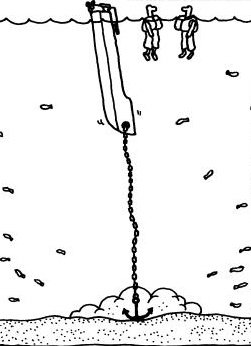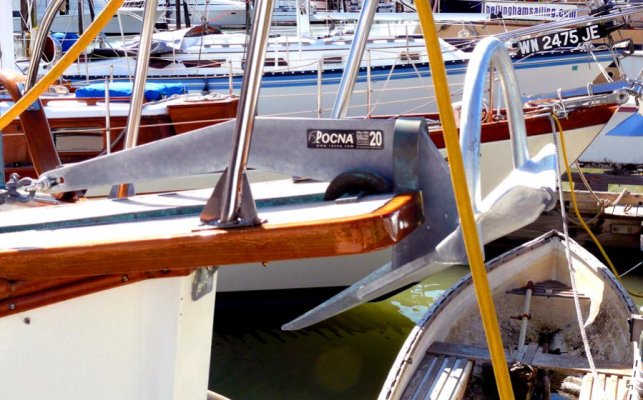Nomad Willy
Guru
Marin wrote:
"Eric--- If you look at a rollbar anchor from the side--- and I can only relate to the Rocna on this since that's what we have--- the fluke is at quite an angle to the shank, much more so than on our previous Bruce or anchors like the CQR or Danforth. So I would think this would encourage the anchor to dig in deep, which is what it seems to do based on the videos and photos I've seen." If I read "quite an angle" to mean wide or higher numerically I personally perceive that this wider angle would inhibit the anchor's ability to set for somewhat complicated reasons I talked about in my previous post. Once the anchor is set and upright a shallower F/S angle (like I think the Rocna and Delta have) would tend to allow the rode to turn the fluke upward at a shallower scope angle as the rode is set for less and less scope. Then the fluke is levered up and out by the shank. The wider F/S angle would permit the anchor to hold at a steeper rode angle ...shorter scope. Visually from the pictures it looks like the Rocna has a fluke that is closer to being parallel to the shank than the Manson and I attribute that feature to be responsible for the alleged tendency for the Rocna to have a bit better holding power at long scope and for the Manson to work better at short scope.
The sudden setting you describe is a feature of my older XYZ. There's no doubt about when it sets but the Manson (in my limited experience) seems to be the opposite. Frequently I'm not sure if it's set. I'll work with it on the way down. Slow setting may not be an indication that the anchor is inferior or would have less holding power. But there are many more things that are more important than holding power in an anchor but it still must hold. So I have renewed interest in my Manson Supreme.
"Eric--- If you look at a rollbar anchor from the side--- and I can only relate to the Rocna on this since that's what we have--- the fluke is at quite an angle to the shank, much more so than on our previous Bruce or anchors like the CQR or Danforth. So I would think this would encourage the anchor to dig in deep, which is what it seems to do based on the videos and photos I've seen." If I read "quite an angle" to mean wide or higher numerically I personally perceive that this wider angle would inhibit the anchor's ability to set for somewhat complicated reasons I talked about in my previous post. Once the anchor is set and upright a shallower F/S angle (like I think the Rocna and Delta have) would tend to allow the rode to turn the fluke upward at a shallower scope angle as the rode is set for less and less scope. Then the fluke is levered up and out by the shank. The wider F/S angle would permit the anchor to hold at a steeper rode angle ...shorter scope. Visually from the pictures it looks like the Rocna has a fluke that is closer to being parallel to the shank than the Manson and I attribute that feature to be responsible for the alleged tendency for the Rocna to have a bit better holding power at long scope and for the Manson to work better at short scope.
The sudden setting you describe is a feature of my older XYZ. There's no doubt about when it sets but the Manson (in my limited experience) seems to be the opposite. Frequently I'm not sure if it's set. I'll work with it on the way down. Slow setting may not be an indication that the anchor is inferior or would have less holding power. But there are many more things that are more important than holding power in an anchor but it still must hold. So I have renewed interest in my Manson Supreme.






